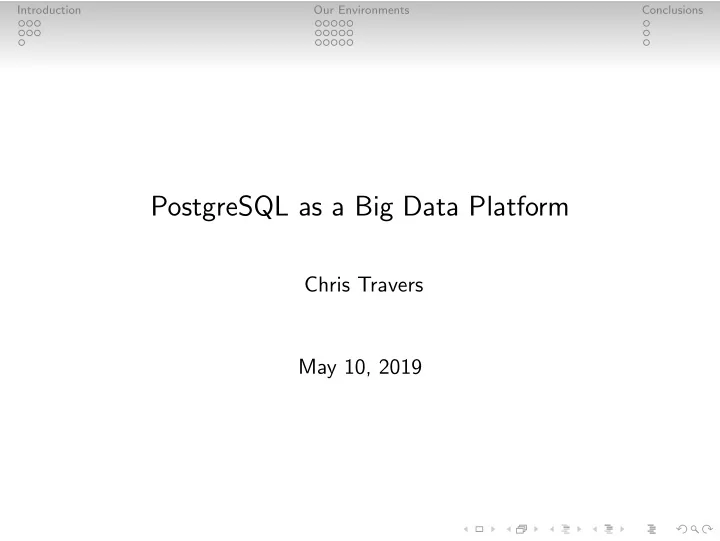

Introduction Our Environments Conclusions PostgreSQL as a Big Data Platform Chris Travers May 10, 2019
Introduction Our Environments Conclusions About Adjust Adjust provides mobile advertisement attribution and analytics on mobile application events. On average we track advertisement performance for 10 applications for each smart phone in use. We focus on fairness and transparency.
Introduction Our Environments Conclusions About Me • Long time software developoer • New Contributor to PostgreSQL • Working with PostgreSQL since 1999 • Head of PostgreSQL team at Adjust GmbH
Introduction Our Environments Conclusions My Team • Research and Development • Database environments supporting diverse products • PB scale deployments
Introduction Our Environments Conclusions Assumptions in Relational Model • Optimized for mathematical manipulations via Set Theory • Real implementations fall short (bags vs sets etc) • Data modelled as tuples (ideally short) where a tuple element is assumed to be atomic. • Think accounting or order management software.
Introduction Our Environments Conclusions Traditional business intelligence (relational) • Same approach mathematically as OLTP • Typically data is historical meaning that it can be inserted periodically. • Sales over time per country is a standard example. • PostgreSQL struggles a bit with BI due to table structure.
Introduction Our Environments Conclusions Industry Trends • Wider variety of source data for analysis (Variety) • Real-time analytics on streams of events (Velocity) • More data than can be managed gracefully on one machine (Volume) Collectively these are known as ”Big Data” and might include analysis of published research, facebook posts, internet-of-things events, or MMO game data.
Introduction Our Environments Conclusions What Big Data Is/Is Not Big Data Is Not Big Data Is: • A set of products • About V3 Problems • A set of technologies • A set of techniques • About following recipes. • About Attention to Detail At Adjust we apply big data techniques to large, high velocity data sets using vanilla Postgres and a lot of our custom software.
Introduction Our Environments Conclusions Introducing our KPI Service Pipeline • Environment Approaching 1PB • Delivers near-realtime analytics on user behavior • 100-300k requests a second • Delivers to dashboard and external API users • Different pieces have different availability considerations
Introduction Our Environments Conclusions Big Data Characteristics • High Volume and Velocity • High availability requirements for Ingestion • Distributed data warehouse queries • Data has has very large clusters of values, making ordinary sharding difficult.
Introduction Our Environments Conclusions Engineering Approach • Pipeline of Data • Highly redundant initial processing nodes • Modestly redundant customer-facing shards • Data moves through a pipeline.
Introduction Our Environments Conclusions Architecture • Initial processing systems log their results • MapReduce to customer-facing shard databases • MapReduce again in delivering data to client • Covered in ”PostgreSQL At 20TB and Beyond”
Introduction Our Environments Conclusions PostgreSQL Challenges • PostgreSQL FDW too latency sensitive to use between datacenters. • Multiple inheritance used for some advanced features makes data schema changes difficult. • Our shards’ WAL traffic is measured in the TB/day.
Introduction Our Environments Conclusions Introducing Bagger • Elastic Search Replacement • High velocity ingestion (1M+ data points/sec) • Very high volume (10PB) • Free form data (JSON documents) • Retention for Limited Time
Introduction Our Environments Conclusions Big Data Characteristics • Very high velocity (up to 1M items per second ingestion) • Very high volume (10PB of data, capped by quantity currently). • Could include all kinds of new data at any time, so must handle variety of semi-structured data quite gracefully.
Introduction Our Environments Conclusions Engineering Approach • Optimize for bulk storage and linear writes • Use PostgreSQL JSONB and similar indexes • Data partitioned by hour and dropped when disks are near full. • Client-side sharding, so dedicated client
Introduction Our Environments Conclusions Architecture • Data arrives by Kafka, partitioned for the dbs • Data partitioned by query pattern and hour • Partitions tracked on master databases • Client written in Perl, which queries appropriate partitions and concatenates data
Introduction Our Environments Conclusions PostgreSQL Challenges • Marshalling JSONB can be expensive • System catalogs on ZFS on spinning disk are slow • Requires significant custom C code in triggers to keep the system fast. • Exception handling in PostgreSQL has been a source of bugs in the past.
Introduction Our Environments Conclusions Introducing Audience Builder • Retargetting platform (describe use case) • Only 12TB but expect to grow • Non-typical query and access patterns • Feature requests that could push this into PB range
Introduction Our Environments Conclusions Big Data Characteristics • High enough velocity that saturation of NVME storage is a concern. • Queries touch very large amounts of data • Expect these issues to become far worse.
Introduction Our Environments Conclusions Engineering Approach • Separation of storage and query • Settled on Parquet as storage format • Columnar data storage useful but most software does not support our access patterns well. • Evaluated a few of alternatives to PostgreSQL here. • Prioritized predictability and extensibility over peak performance
Introduction Our Environments Conclusions Architecture • Parquet files on CephFS • PostgreSQL as query engine only • Wrote Parquet FDW for PostgreSQL • With tuning and optimization, as fast as native files. • Data arrives via Kafka and is written to Parquet files and these are registered with the database. • Pluggable storage might be of interest here. https://github.com/zilder/parquet fdw
Introduction Our Environments Conclusions PostgreSQL Challenges • Hundreds of thousands of tables • Performance requires tables to be physically sorted • Heavy reliance on streaming APIs (COPY)
Introduction Our Environments Conclusions Key Takeaways • Big Data is about technique, not technology • PostgreSQL is quite capable in this area • Careful attention to requirements is important • Every big data system is different.
Introduction Our Environments Conclusions Major Open Source Software We Use • Apache Kafka • PostgreSQL • Redis • Go • Apache Flink • CephFS • Apache Spark • Gentoo Linux
Introduction Our Environments Conclusions Thank You Thanks for coming. Any questions? chris.travers@adjust.com
Recommend
More recommend